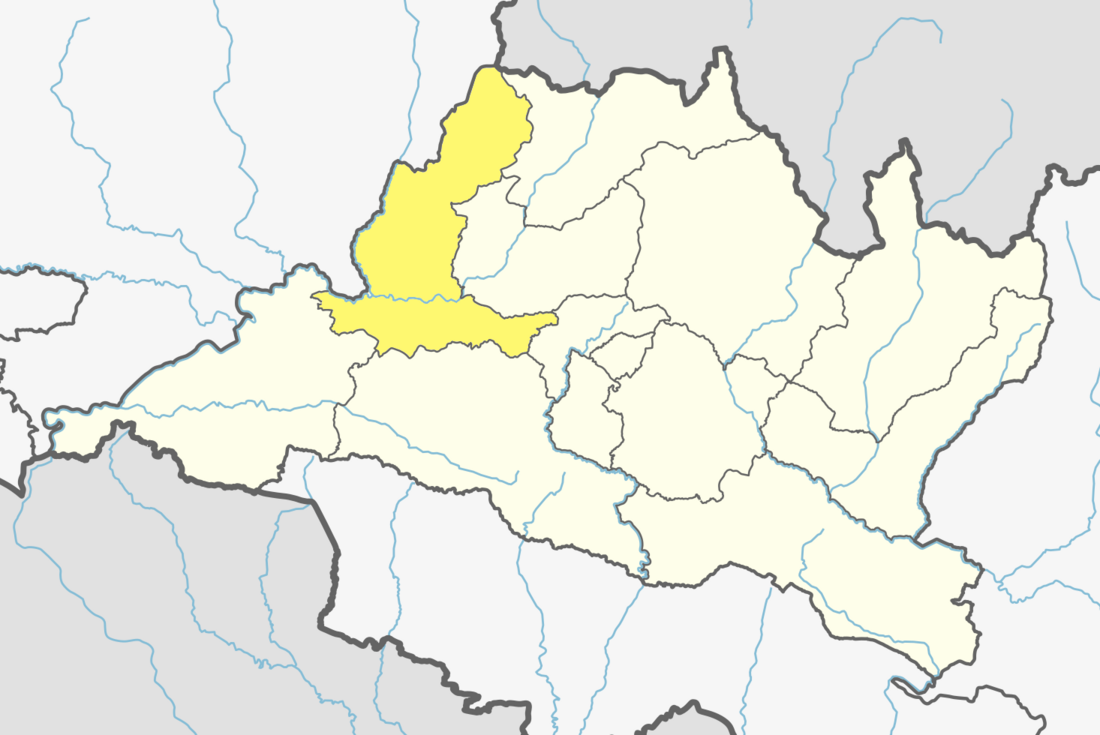Top Qs
Timeline
Chat
Perspective
Dhading District
District of Nepal From Wikipedia, the free encyclopedia
Remove ads
Dhading District (Nepali: धादिङ जिल्ला ⓘ), a part of Bagmati Province, is one of the seventy-seven districts of Nepal. The district, with Dhading Besi as its district headquarters, covers an area of 1,926 square kilometres (744 sq mi), had a population of 338,658 in 2001[2] and 336,067 in 2011.[1]
Remove ads
Geography and climate
Summarize
Perspective
Dhading District spreads from 27'40" E to 28'17" E and 80'17"N to 84'35"N.[3] The mountain range Ganesh Himal is the predominant mountain range located within Dhading. Some of the peaks are over 7,000 metres (23,000 ft). The highest point in the district is 7,104-metre Pabil.[4] The 8,000-metre (26,000 ft) and the mountain Manaslu is clearly visible from much of Dhading, although it is located within the bounds of Gorkha. The transnational Prithivi Highway connecting Kathmandu, Chitwan and Pokhara runs through the southern portion of the district, making for easy access to the Kathmandu valley. The road parallels the Trishuli River. The western border with Gorkha is bisected by the Budigandaki River.
The district is bounded by
- East: Kathmandu, Rasuwa and Nuwakot
- West: Gorkha
- North: Rasuwa and Tibet
- South: Makwanpur and Chitwan
Dhading is the only district of Nepal which ranges from the mountain Ganesh Himal to the Churevawar pradesh of Terai (Chitwan). The district, with Dhading Besi as its district headquarters, covers an area of 1,926 square kilometres (744 sq mi) and has a population (2001) of 338,658.[2] Dhading is the district with the most rural municipalities in Nepal i.e. 11. Dhading is 80% farmland and 20% forest. The western border with Gorkha is bisected by the Budhigandaki River.
The people of the district are primarily Bhramin and Chetri in the south and Tamang and Gurung in the north, with much of the center Newari. Gurkha route, the birthplace of founder of Nepal King Prithivi Naryan Shah crosses through Dhading.
Remove ads
Rivers
The main river of the Dhading district is Budi Gandaki which comes from Ganesh Himal and passes through Arughat Bazaar and Salyantar and meets Ankhu khola at Narsingha Dhamm. Budhi Gandaki separates the district from Gorkha district. The Trisuli River, which comes from Nuwakot, also passes through Dhading. There are 25 small rivers, the main being Charoudi, Malekhu, Galtukhola, Belkhukhola, Chiraudikhola, Maheshkhola, Aansi, Thopal, Manukhola, Kastekhola, and Mastekhola. Besides these, there are over 1743 smaller rivers, springs and seasonal streams.[6]
Remove ads
Demographics
Summarize
Perspective
At the time of the 2021 Nepal census, Dhading District had a population of 325,710. 7.38% of the population is under 5 years of age. It has a literacy rate of 72.40% and a sex ratio of 1048 females per 1000 males. 87,977 (27.01%) lived in municipalities.[8]
Castes/ethnic groups in Dhading District (2021)[9]
Ethnicity wise: Hill Janjatis made up the largest population, being nearly 49% of the population. Tamangs were the largest Hill Janjatis (22%), with Magars being 8% of the population. Chhetri and Bahun made up 20% of the population.[9]
As their first language, 67.05% of the population spoke Nepali, 20.11% Tamang, 2.95% Chepang, 2.74% Magar, 2.66% Gurung, 1.59% Ghale and 1.30% Nepal Bhasha as their first language.[10] In 2011, 70.7% of the population spoke Nepali as their first language.[11]
Religion: 70.71% was Hindu, 20.26% Buddhist, 7.55% Christian, 0.43% Kirat and 0.41% Islam.[12]
Remove ads
Religious temples
Summarize
Perspective
Dhading District has many religious temples. Among them is Tripurasundari Mai which lies in the northern part of the district. Siddha Than in Siddhalekh Rural Municipality is a Hindu religious site. Others include the Bhairabi Temple in Sunaula Bazar. Sri Nrsimha Dham Kshetra in Salyantar is a historical religious site for the Vedic Sanatan Hindu people, where Jagannath Foundation – Sri Rupanuga Para Vidyapeeth, Bimala Devi Temple, Shesa Temple, Sada Shiva and ancient Nrsimha Deva temple, and Ganga Jamuna temple are attractions. Kot Devi is a religious site in Jwalamukhi Rural Municipality, Maidi. Kalidevi Temple is also one of the popular religious temples (Devi Mandir) located in Dhunibeshi Municipality ward no. 6. Amleshwor Mahadev Temple in Mahesdovan, Jwalamukhi, is also one of the main religious temples of Dhading. Pasupatipati and Krishna mandir covers the district headquarter, Dhading Bensi. Madevthan of Palpa Bensi is also one of the religious sites of Dhading. Dhola Mandali temple of Dhola is a popular Hindu temple. Every Tuesday people used to cut she-goats in Mandali Thaan.[clarification needed] Girls and women are not allowed to go there. The origin of the Muktinath temple of Mustang is Dhading. In Dhading, Muktinath Temple is located at Siddhalek Rular Municipality, nearly Kalupanda Marg.[clarification needed]
Remove ads
Administration
Dhanding district consists of two municipalities and 11 rural municipals.
Municipalities
- Dhunibeshi Municipality
- Nilkantha
Rural municipals
Towns and villages

- Dhunibeshi Municipality
- Khanikhola
- Naubise
- Gaucharan
- Dharke
- Jungekhola
- Madhevbeshi
- Simle
- Aginchok
- Baireni
- Baseri
- Benighat
- Bhumesthan
- Budhathum
- Chainpur
- Chhatre Dyaurali
- Dangsing
- Darkha
- Dhola
- Dhusha
- Dhuwakot
- Gajuri
- Gaunkharka
- Gerkhu
- Ghussa
- Goganpani
- Gumdi
- Jharlang
- Jiwanpur
- Jogimara
- Jyamaruk
- Kalleri
- Katunje
- Kebalpur
- Khalte
- Khari
- Kiranchok
- Kumpur
- Lapa
- Mahadevsthan
- Maidi
- Marpak
- Mulpani
- Murali Bhanjyang
- Nalang
- Naubise
- Nilkantha Municipality
- Phulkharka
- Pida
- Ranibari
- Rigaun
- Salang
- Salyankot
- Salyantar
- Sangkosh
- Satyadevi
- Semjong
- Sirtung
- Sukabhanjyang
- Sunaula Bazar
- Tasarphu
- Thakre
- Tipling
- Tripureshwar
Remove ads
See also
- Charaundi (Commercial zone)
- Zones of Nepal
References
External links
Wikiwand - on
Seamless Wikipedia browsing. On steroids.
Remove ads

